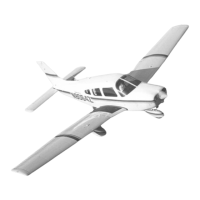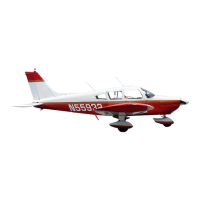PIPER AIRCRAFT, INC.
PA-28-161, WARRIOR III
MAINTENANCE MANUAL
2E18
24-30-00
PAGE 26
Nov 30/06
G. Discharge
The capacity of a storage battery is measured in units of ampere hours, which is the product of the
electrical current in amperes multiplied by the time in hours. Although current may be obtained after
the end of the time, the voltage of the battery has dropped to a point beyond which it is not very
useful. The ampere hours which may be obtained from a battery are greater for a long low-rate or
intermittent rate discharge than for a short high-rate discharge because the voltage will drop faster
at the higher discharge rate. The maximum permissible rate of discharge is limited only by the
current-carrying ability of the wiring, motor, or other apparatus to which the battery is connected or
by the current-carrying ability of the cell terminals and connectors and not by the plates themselves.
Chart 8, below, shows the recommended discharge rate.
H. Temperature Considerations
Operation of storage batteries beyond their ambient temperature or charging voltage limits will
result in excessive cell temperatures leading to electrolyte boiling, rapid deterioration of the cell, and
finally battery failure. The relationship between the maximum charging voltage and the number of
cells in the battery is also significant, since this will determine (for a given ambient temperature and
state of charge) the rate at which energy is absorbed as heat within the battery. The maximum
voltage per cell should not exceed 2.35 - volts, and the maximum temperature should not exceed
115° F.
Low electrolyte temperatures temporarily reduce the battery capacity and the freezing point
depends on the specific gravity. To prevent freeze damage, maintain the specific gravity at a
reasonably high level as indicated by Chart 9.
NOTE: Lead-acid batteries are subject to a constant discharge due to the internal chemical action.
CHART 9
ELECTROLYTE FREEZING POINT
Specific Gravity ° C ° F
1.300 -70 -95
1.275 -62 -80
1.250 -52 -62
1.225 -37 -35
1.200 -26 -16
1.175 -20 -4
1.150 -15 5
1.125 -10 13
1.100 -8 19
CHART 8
BATTERY DISCHARGE RATE
Battery Volts Amp Hours (5 HR Rate)
GIL-G243 24 15.5

